
Features
Training
Extrication Tips: April 2010
In the January column on big rig rescue, we discussed the anatomy of large trucks and trailers and a few late-model design characteristics that pertain to their construction. Here, we will focus on arrival, assessment, stabilization and interior rescue duties.
April 12, 2010
By Randy Schmitz
In the January column on big rig rescue, we discussed the anatomy of large trucks and trailers and a few late-model design characteristics that pertain to their construction. Here, we will focus on arrival, assessment, stabilization and interior rescue duties.
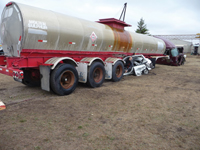
|
| Photo 1: Most fatalities in two-vehicle crashes involving passenger vehicles and big trucks are the occupants of the passenger vehicle.
Photos by Randy Schmitz
|
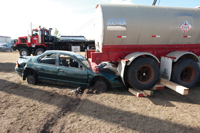 |
| Photo 2: The front ends of passenger vehicles often slide under cargo units of large trucks.
|
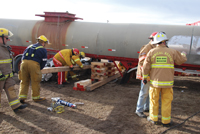 |
| Photo 3: Truck and trailer must be stabilized before rescuers begin work. Advertisement
|
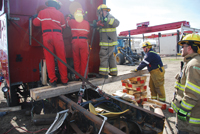 |
| Photo 4: Cab must be secured with chains or ratchet straps.
|
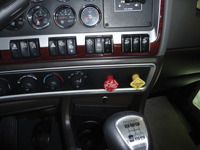 |
| Photo 5: Deploy park brake or pull yellow airbrake button and shut off ignition switch.
|
Large trucks
Large truck safety is an important concern for all highway motorists. Fatalities from large truck crashes have been steadily increasing. Large trucks — including tractor-trailers, single-unit trucks and certain heavy cargo vans with gross weight more than 10,000 pounds — account for a disproportionately large share of traffic deaths based on kilometres travelled.
As well, people in passenger vehicles are especially vulnerable in collisions with large trucks because of the great difference in weight. The majority of the fatalities in two-vehicle crashes involving passenger vehicles and large trucks were the occupants of the passenger vehicles (see photo 1).
Dispatch
As first responders, gaining as much information from your dispatch centre as possible before your arrival at the scene of an incident involving large vehicles is a priority. Typical questions that should be asked are the location, the number of vehicles involved, a description of the load or cargo and the hazards involved, as the truck may be hauling hazardous material.
Gasoline, diesel and fuel oil comprise more than 95 per cent of all hazardous materials shipped in the U.S. and Canada. If you suspect that hazardous materials may be involved, prepare to gather information on the proper handling of these volatile products. Resources such as CANUTEC, CHEMTREC or the DOT Hazardous Material Response Guidebook should be consulted and/or have the local hazardous response team dispatched as soon as possible. Consider calling a heavy wrecker or have one put on standby.
Arrival at the scene
Upon arrival, size up the incident from a safe distance and take note of any placarding on the container or vessel; a quality set of binoculars is essential to help identify the cargo. Knowing and understanding the different sizes, shapes, types of trailers and what products they are designed to carry will help with the hazard identification and assessment. (For our purposes, we will assume there are no hazards present.)
Outer and inner circle surveys
As with any proper incident command system, outer and inner circle surveys are essential for successfully identifying additional hazards, the number of patients, the degree of entrapment, any spilled product and other potential problems. Having a charged line deployed at these types of incidents cannot be underestimated. Always start by completing the outer survey with a full 360-degree viewpoint; avoid having rescuers conduct the inner survey too early in case a potential hazard is identified during the outer survey. Examples of potential hazards are downed electrical wires that are not initially apparent, electrical kiosks that have been run over and are hidden by the wreckage or propane tanks from holiday trailers in situations where the vehicle has overturned and the hazard is no longer visible. Rescuers should never perform inner and outer circle surveys empty handed; always have a fire extinguisher, blocking and other necessary tools in hand. Watch for patients who may have wandered off. This is also the time to request additional resources.
Initial hazard control
A blanket of foam will suppress vapours and control diesel or gasoline fuel spills from saddle tanks that may have been breached in the accident. Diesel fuel is quite slippery on pavement; ensure that rescue crews are mindful of this when working at the scene. Absorbent material can also be considered to minimize this hazard. Environmental concerns have to be taken into consideration by the incident commander for any product that has leaked out. Containment diking of the product to stop any dangerous goods from entering waterways or sewer systems is paramount.
If feasible, inner circle survey personnel should quickly attempt to chock the tires of all vehicles involved if it is safe to do so. Start the interior assessment at the point closest to the impact. Once rescuers are in a position to make eye contact with the driver(s), they should also attempt verbal contact. Standard dialogue should follow these lines:
Are you hurt?
- Is there anyone in the vehicle with you?
- Please turn of the engine.
- What kind of cargo are you hauling?
- Do you have shipping papers or cargo manifests? (Manifests should be obtained once medical aid enters the vehicle’s cab.)
Manifest documents are required to be within reach of the driver; manifests are often located in the operator’s door pocket.
Stabilization
Stabilization is of the utmost importance; large trucks require more stabilization than passenger vehicles when disentanglement/extrication operations are to be undertaken. Stabilization methods will differ depending on whether the unit is upright and still on its wheels, laid over on its side or if another vehicle is underneath. Many passenger car and light truck fatalities are due to side and rear impacts with large trucks. Small vehicles involved in side and rear crashes with large trucks have much higher than average frequency of serious physical injury. The front ends of passenger vehicles often slide underneath the cargo units of large trucks (see photo 2); in some cases, the passenger compartment is sheared off. Passenger vehicles are also subject to front underride of large trucks as well as rear override by large trucks; both situations result in serious injuries or fatalities to occupants of the passenger vehicles.
Upright truck and trailer
If accessible, use the airbrake system to your advantage by uncoupling the two red and blue glad hands behind the cab area attached to the pogo stick. This will engage the emergency brakes of the trailer to stop any forward or backward movement. If possible, avoid cutting the coloured hoses to release the air as this will make towing the unit more difficult.
There are various methods of stabilization depending on your equipment. Heavy duty struts are an excellent option if your department has them. Attaching the strut heads to frame rails/members or other structurally sound components is extremely important to reduce shifting and prevent load failure. Other options are to use a combination of struts and box cribs, including those made of plastic or wood. The minimum size should be 4 in. x 4 in. x 24 in. long (5 cm x 5 cm x 60 cm). Using the two-crib-per-layer method, a box can hold up to 24,000 lbs (10,000 kg). Adding one more piece of cribbing to make three cribs per layer increases the weight to 48,000 lbs (20,000 kg). Ideally the crib stack height should not exceed twice the length of the cribbing; in this case, 48 in. (120 cm) would be the maximum height. Using 6 in. x 6 in. x 24 in. (15 cm x 15 cm x 60 cm), two per layer, the weight increases to 60,000 lbs (27,000 kg) and to 120,000 lbs (54,000 kg) by adding a third piece to the layer (see photo 3). A good rule of thumb for estimating the weight of a large vehicle is to multiply the number of axles by 20,000 pounds (9,000 kg). Lastly, the most desirable option would be to use basic stabilization with a commercial tow truck on scene. These large tow trucks carry towing straps/slings which, along with struts and or box cribs, provide a quick and safe method of stabilization. If applicable to the incident, some good locations to build crib stacks are under frame rails for added strength or near the underside/override protection guard at the rear of a trailer. These are engineered to be structurally sound and are lower to the ground, which is ideal as the box crib height required is minimized for a faster deployment.
Other good areas for stabilization are the dolly jacks on the trailer section of a truck and trailer, which can be lowered and used for additional stabilization only if they have not been damaged. Blocking may be used under the dolly jack base plates to increase the lift height if raising of the front end of the trailer is anticipated during extrication operations. Note: if this is the intention, the fifth wheel that attaches to the trailer’s kingpin must be released before the trailer jacks are activated. A pull handle on the operator’s side of the fifth wheel plate will disconnect the kingpin. If a truck and trailer is on its side there may be many voids that need to be filled; corners are a good location to insert cribbing or large wedges as they can still be intact and remain relatively strong for support. Another important task is to ensure the integrity of the cargo container. Avoid opening side resting “barn door style” trailer doors unless absolutely necessary as they are acting as a structurally integral component in their closed position. Opening them could cause the box trailer to collapse or the contents inside to shift and fall out. Check the refrigeration unit; if it is not posing a problem or hazard, leave it on to preserve the cargo. It will have a separate power unit and fuel tank so it could start up automatically any time.
If a passenger vehicle has underridden a tractor-trailer unit from either the rear or the side, truck underride and override guards can substantially mitigate the severity of passenger vehicles-large truck crashes. This protection begins with energy absorbing rear underride guards that are adequate for preventing passenger vehicles from underriding large trucks. It will be beneficial to crib up near the area of the fifth wheel to reduce movement. Wedges or 4 x 4 blocking should be inserted between the top of the fifth wheel plate and the underside of the trailer where the kingpin intersects. Rescuers must also check to see if the cab of the large truck has become dislodged from the frame; if so, it must be secured with chains or ratchet straps to prevent movement and allow it to be made safe for entry and perhaps extrication operations if necessary. Use pike poles to place straps or chain over cab.
Puncture a small hole in the sheet metal, fibreglass or Metton material of the lower part of the cab to secure a ratchet strap hook into. From there hook the other end to the frame below, which will then allow a quick lockdown. The truck /trailer combination is ready for rescuer entry (see photo 4).
Gaining entry into the cab
If the cab of the truck is not compromised from the crash, the windows may be your best point of access. Of course, you should always try the doors first, as this may be all it takes to gain entry. The adage “try before you pry” applies here. If the doors are not an option, then use the front windshield. The windshields are large and usually separated by a centre post that can easily be removed. If the glass is gasket mounted, removing it will be quick and easy. If the centre post is cut and removed, it will allow a large access area for access and, possibly, for patient removal. Take full advantage of this option if possible.
Cab hazards while gaining entry
Hot engine coolant from the heater core that has been breached from the crash may have burned the occupants. Be on the lookout for weapons, animals (pets such as dogs) and be mindful of exposed wiring, hydraulic oil, fuel leaks and fumes while inside the cab
Cab interior rescuer duties
Ensure engine shutdown prior to battery disconnection – turn off the master switch. Inform outside rescuers that it is OK to disconnect the batteries; as with most standard battery shutdown protocols, negative (black) first then positive (red) to reduce the amount of arcing. Use latex medical gloves or tape to cover cable ends. Deploy the park brake or pull the yellow airbrake button and shut off the ignition switch. Start patient assessment; inform command of degree of entrapment and the number of patients on board (see photo 5).
This concludes all the steps that need to be undertaken by rescuers in regards to preparing the vehicles for extrication.
In July we will discuss lifting options and techniques for extrication.
Randy Schmitz is a Calgary firefighter who has been extensively
involved in the extrication field for 17 years. He is an extrication
instructor and has competed internationally. He is the education chair
for Transport Emergency Rescue Committee (T.E.R.C.) in Canada, a
T.E.R.C. International extrication judge and a tester and evaluator for
manufactured prototype products for extrication equipment. He can be
reached at rwschmitz@shaw.ca
Print this page